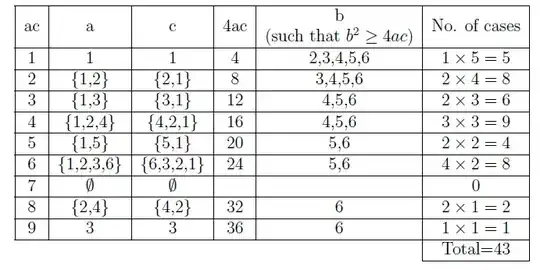We show the path to the answers using somewhat tedious listing. The symmetry between $a$ and $c$ could be used to cut down on the work. We use the fact that the quadratic has real solutions if and only if the discriminant $b^2-4ac$ is $\ge 0$, and equal solutions if and only if $b^2-4ac=0$.
Equality is easiest. This happens if and only if $b^2=4ac$. That forces $b=2$, $4$, or $6$. If $b=2$, we need $a=c=1$, so the only configuration is $(1,2,1)$. If $b=4$, we want $ac=4$, which can happen in $3$ ways, $(1,4,4)$, $(4,4,1)$, and $(2,4,2)$. Finally, if $b=6$, we want $ac=9$, which only happens with the configuration $(3,6,3)$. Each configuration has probability $\frac{1}{6^3}$, so the required probability is $\frac{5}{216}$.
For real solutions , we want $b^2\ge 4ac$. That cannot happen if $b=1$. If $b=2$, it can only happen if $ac=1$, giving a contribution of $\frac{1}{216}$. If $b=3$, we want $ac\le 2$, which can happen in $3$ ways, for a contribution of $\frac{3}{216}$.
We leave the cases $b=4$ and $b=5$ to you. For $b=6$, we want $ac\le 9$. Let us list the ways. With $a=1$, $b$ can have $6$ values. With $a=2$ there are $4$. With $a=3$ there are $3$. With $a=4$ there are $2$. And there are $1$ each for $a=7$ and $a=6$. That gives a contribution of $\frac{17}{216}$.
For complex, one could say that the probability is $1$, since every real number is in particular a complex number. But what is probably intended is complex and non-real. Then the required probability is $1$ minus the probability the root(s) are real.
